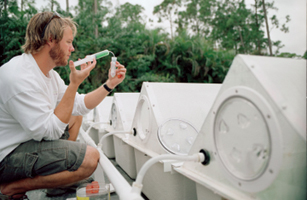
PRECISION GROWTH: Algenol biologist Jesse Phillips-Kress tests an algae strain from the company's sun-absorbing bioreactors
Paul Woods didn't blindfold me as we drove through the overgrown plantations outside West Palm Beach, Fla., but he looked as if he was considering it. Woods is the brash 46-year-old CEO of biofuels start-up Algenol — and he takes his company's secrecy seriously. Aside from officials from the U.S. Department of Energy, I was the first outsider ever to visit Algenol's modest testing facility. We turned off a country road opposite a llama ranch, and stopped at an unmarked circle of trailers in the middle of a clearing in the palm trees. There, sitting on a section of concrete half the size of a basketball court, was what Woods has been hiding from the world: several rows of long white tubs fitted with plastic windows that let in sunlight, each filled with a liquid the dark green of moss. The mixture was water and algae — microscopic plantlike organisms that feed off sunlight and carbon dioxide. With the proprietary algae happily multiplying, Woods explained that he and his partners intend to produce a biofuel greener and cheaper than oil or corn-fed ethanol: "We want to do 20 billion gallons eventually, and we will compete on price. We're a year away from sales."
This sort of audacious prediction used to be commonplace in the biofuel industry, but 2008 was not kind to those who want to replace petroleum with plants as delegates gathering at the World Future Energy Summit in Abu Dhabi on Jan. 19 are sure to discuss. The U.S. corn-ethanol industry, which had grown fat on government subsidies, crashed last year. Perhaps worse, a series of influential studies argued that, far from being a green alternative, corn ethanol drives food-price inflation and produces higher levels of greenhouse-gas emissions than gasoline, because biofuel subsidies encourage forest-clearing. "If anything, traditional biofuels like ethanol and biodiesel are moving us in the wrong direction," says Nathanael Greene, an analyst at the U.S.'s Natural Resources Defense Council (NRDC).
But it would be a mistake to abandon the biofuel option now. The fact is that cars, trucks and planes contribute 13% of the world's greenhouse-gas emissions — the rates are far higher in developed countries — and there are no immediate solutions capable of breaking the planet's dependence upon jet aircraft and internal-combustion engines for transportation. Even promising technologies like electric vehicles remain years away from reaching critical mass, and would require vast changes to transportation infrastructure in the form of recharging stations and cleaner electricity. "The bottom line is that it is simply premature to rule out any option," says John DeCicco, senior fellow for automotive strategies at the U.S.'s Environmental Defense Fund. "The problem is too big." Fortunately, firms in the U.S. and Europe are exploring alternatives to food-crop biofuels, using everything from switchgrass to algae. Each technology has drawbacks, and none is fully ready, but in a warming world of finite oil supplies, we have little choice but to pursue them.
Applying the Science
Corn and sugarcane were the first crops to be turned into biofuels because it's easy to ferment the sugars in the plants' starches into ethanol. But there's more to plants than just edible starches and sugars. Take cellulose, the tough, abundant organic molecule that composes the cell walls of all plants. Nature provides enzymes — in the stomach of a cow that chews grass, or in a termite that eats through wood — that turn cellulose into sugar. But on an industrial scale, converting cellulose to a usable form to make fuel "is currently too expensive," according to Lee Lynd, an environmental engineer at Dartmouth College in the U.S. and co-founder of Mascoma, a biofuels start-up that's experimenting with cellulosic technologies.
Progress in the field is slow. Now, however, several American companies are vying to become the first to market cellulosic ethanol, aided in part by a new U.S. tax credit worth $1.01 per gallon for makers of such biofuels. That state aid will help defray high initial costs, and make cellulosic more competitive with oil. At Mascoma, Lynd is focused on finding and using bacteria that can digest cellulose and spit out ethanol in a single step — he calls it consolidated bioprocessing. It could reduce production costs so dramatically, he believes Mascoma will eventually be able to churn out ethanol more cheaply than gas, even without government subsidies. Big players are interested (Mascoma recently signed a deal to develop cellulosic fuel for General Motors), and the company plans a commercial facility in Michigan.
Others are also forging ahead. Verenium, a two-year-old firm based in Cambridge, Mass., has almost completed a demonstration plant in Louisiana — the first on American soil — that will produce 1.4 million gallons (5.3 million L) of cellulosic ethanol a year, chiefly from sugarcane residue. Verenium hopes that a recently formed partnership with energy giant BP can speed up the process. "You can do something in a lab and it will be perfect," says Verenium's CEO, Carlos Riva. "But what happens in the real world is quite different. You have to learn by doing."